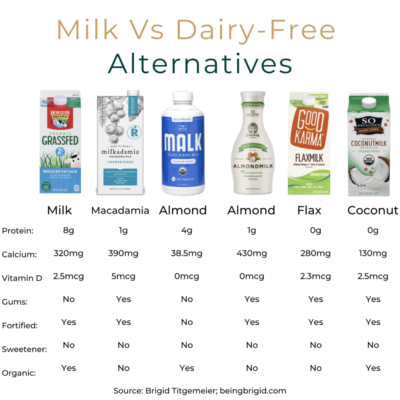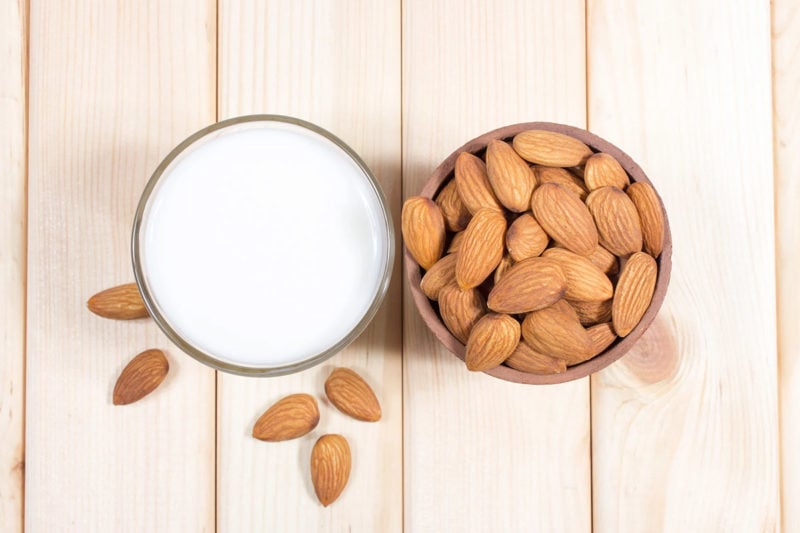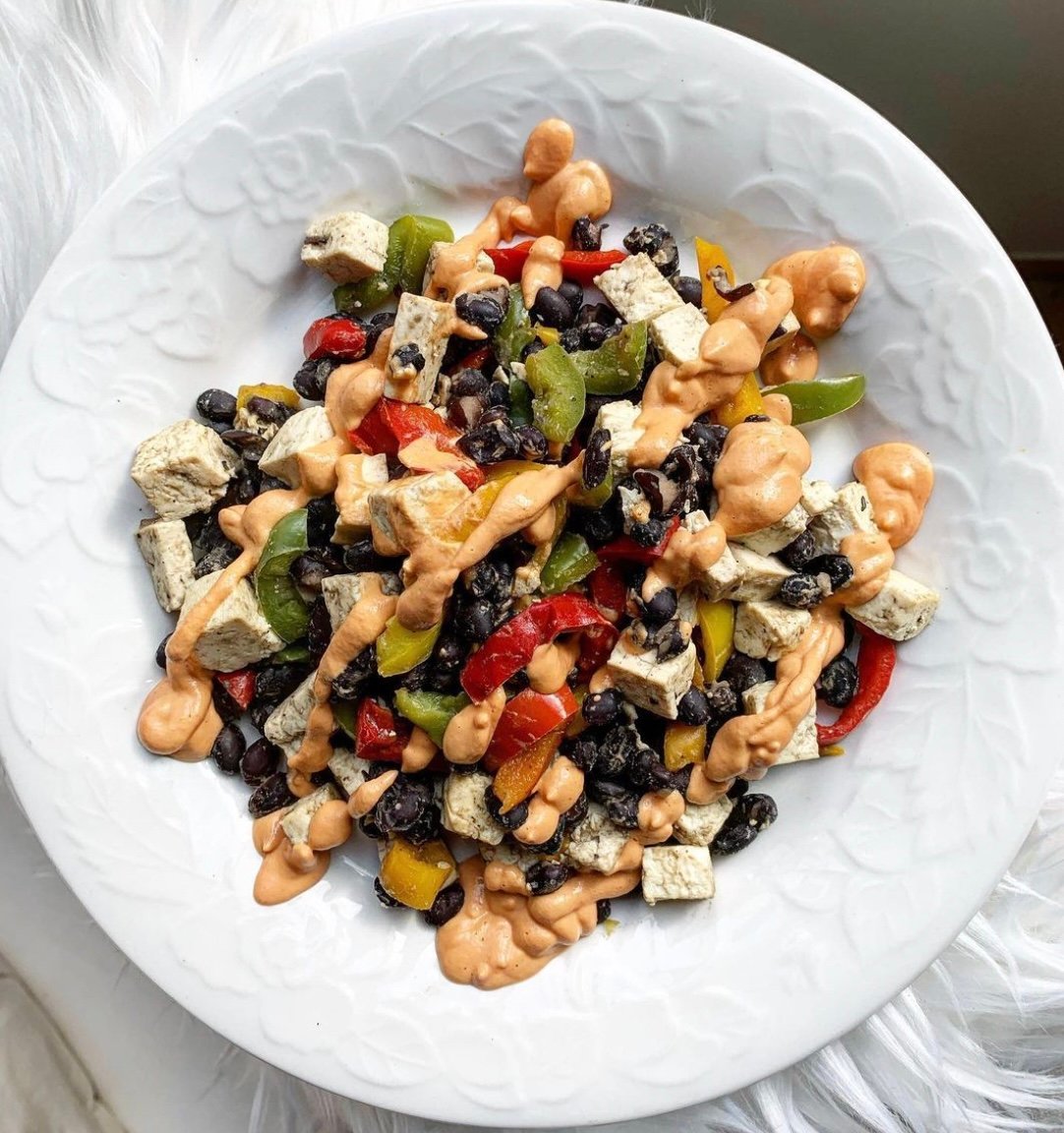In the 1980s, commercials claimed that milk does a body good. But with sales steadily declining in the last two decades, it’s clear not everyone agrees. Yes, milk can be an easy source of protein and calcium, but at the same time, some people can’t tolerate dairy, and others avoid it for other health or ethical reasons.
Enter milk alternatives. Made from nuts, seeds, and grains, these beverages are taking off: In 2020, Americans bought 20% more plant-based milks than they did in 2019. Whether you’re all-in on alternatives or you simply want to switch up your milk here and there, the variety of options offers something for everyone—but some are much better than others when it comes to metabolic health.
The Problems with Milk
Some people choose to eat dairy, but there are various reasons to avoid it altogether or at least minimize intake:
- Some dairy prompts your body to release far more insulin than would be expected given its glycemic index (its sugars are mostly lactose, not glucose). But research is conflicted about what effect this ultimately has on metabolic health.
- About 36% of Americans have lactose malabsorption, which can cause lactose intolerance and an upset GI system if they consume anything containing lactose. Cutting dairy from their diet is an easy way to eliminate this sometimes painful situation.
- Other people experience undesirable side effects when they consume the dairy proteins, including congestion and acne. It’s unclear exactly why this is. One theory is that dairy can trigger inflammation in the body, which can lead to nasal congestion. Other research suggests that consuming dairy increases levels of the hormone insulin-like growth factor 1 (IGF-1), in turn increasing the production of sebum (a.k.a. oil). Too much sebum can clog pores, resulting in pimples.
- Some people prefer to cut back or eliminate their consumption of animal products like dairy for reasons such as animal welfare or the environmental impact: The combined emissions from the world’s 13 largest dairy businesses grew by 11% between 2015 and 2017.
How to Choose a Milk Alternative
Most of these milks are made in a similar manner: The nut, seed, or legume is soaked. It’s then ground into a paste and any particles (from things like the outer shell on oats—the bran—or almond skins) are filtered out so the final product will be smooth. To turn the paste into a milk-like beverage, manufacturers add water, and sometimes other ingredients, such as sweeteners, vitamins, minerals, oils, salt, flavorings, and other substances that stabilize the mixture or give it consistency.
Two ingredients to look for and avoid:
- Sugar: Different brands and flavors of non-dairy milk contain varying amounts of sweetener—sometimes more than 4 teaspoons of added sugars per serving. Vanilla and chocolate flavors tend to be the worst culprits. Always opt for unsweetened varieties.
- Carrageenan: Some brands add this extract from red seaweed to thicken and stabilize plant-based milks. However, some research links carrageenan to gastrointestinal inflammation, which may lead to inflammatory bowel diseases (IBDs) or trigger flare-ups for those who have an IBD.
Additionally, if you have a lot of GI symptoms, you may find that milk alternatives made without gums (such as gellan gum or locust bean gum) sit best with your system. Although these ingredients are considered safe, they can be difficult to digest—and that can cause a lot of discomfort if you have compromised gut health, says Functional Medicine Registered Dietitian Brigid Titgemeier. (Just remember that if a product is free of gums, you need to shake the bottle well before drinking, as the ingredients will separate.)
Some milk alternatives can be a great source of calcium, which can be challenging to get for dairy-free eaters. This calcium is added—often in the form of calcium carbonate—and can provide about 30% of the daily recommended intake. However, know that added minerals and vitamins typically come along with stabilizing gums (so the nutrients remain suspended in the drink and don’t settle to the bottom of the container). If you opt for a product with few ingredients to avoid stabilizing gums, you will also miss most of the additional calcium. Be sure you make up for it in the rest of your diet.
Lastly, Titigemeier adds, if you can, select organic, non-GMO milk alternatives to avoid pesticides and other chemicals that may mess with your metabolic health.
The Worst Milk Alternatives for Blood Sugar
Not all plant-based milks are created equal. Certain base ingredients are more likely to spike blood sugar:
- Oat milk: Of all the options, “oat milk is the worst for blood sugar,” says Titgemeier. Even if an oat milk is unsweetened, the nutrition label will list added sugars. That’s because during the manufacturing process, enzymes are added to break down oat starch so the milk is creamy. Because the longer chains of oat carbohydrates are broken down into shorter chains of simple sugar like maltose, it is considered added sugar on a nutrition facts label.
- Rice milk: Oat and rice milk are naturally higher in carbs—especially compared to nut milks—because the grains themselves have more carbs than nuts. And with 22 grams of carbohydrates and not even 1 gram of fiber or protein per cup, rice milk, even unsweetened, is very likely to trigger a blood sugar surge.
5 Milk Alternatives to Consider
On the other hand, the five milk alternatives below stand out for their nutritional and metabolic health benefits. Be sure to always look for unsweetened! Remember to always read the labels because every brand of plant-based milk has slightly different ingredients and nutritional profiles can vary by a fair amount. (For example, one brand of cashew milk has 130 calories per cup, while another has 25 calories per cup.) This will depend on the ratio of nuts to water, which varies with each brand.
- Almond milk: The fat in almond milk is predominantly monounsaturated fat. Eating more of this fat and less carbohydrates or saturated fat may help control blood sugar and improve insulin resistance. Almond milk’s mild, nutty flavor makes a great base for chia pudding or smoothies. However, this somewhat thin option can curdle in coffee.
- Cashew milk: Like almond milk, cashew milk tends to be low in calories and rich in monounsaturated fats. Yet it’s thicker and creamier than almond milk, with a mild, slightly sweet flavor, all of which makes it a good option for plant-based cream sauces, soups, and baked goods.
- Hemp milk: An option for people with nut allergies, hemp milk provides 2-3 grams of protein, a dose of heart-healthy unsaturated fatty acids, and omega 3s in every cup. It does tend to be an acquired taste, though—some find it a bit “grassy.” The thick, creamy consistency is good to create sauces, or try it in baked goods.
- Coconut milk: About 95% of the fat in coconut milk is saturated fat. While these fats are slow-digesting and therefore satiating, it’s best metabolically to favor unsaturated fats because eating high amounts of saturated fat appears to decrease insulin sensitivity by 25% in the short term. A cup of coconut milk here and there is fine for most people, but too much of any source of saturated fat may be associated with decreased insulin sensitivity. Also note that coconut milk “beverage” (sold in cartons) is different from canned coconut milk. The milk alternative is mostly water with some coconut, while the canned variety is half coconut cream and half coconut water. It’s therefore much thicker, even richer, and higher in fats and calories. Use coconut milk for creamy soups, chia pudding, smoothies, or chocolate avocado mousse, or try it for baking, as long as you like a hint of coconut in the recipe you’re making.
- Flax milk: Compare labels before buying flax milk: Some brands provide 4 grams of fiber per cup, while others have no fiber. Flax is a source of anti-inflammatory omega-3 fatty acids and is an option for those with nut allergies. Use the creamy, slightly earthy-tasting milk in smoothies, baked goods, or breakfast items like pancakes and waffles.

How to Make Your Own Milk Alternative
Avoid added sugars, gums, and other unnecessary ingredients by making your own milk alternative at home. If you have a high-speed blender (and ideally some cheesecloth), it’s easy. You can always double or triple the recipe during a weekend meal prep to help set you up for success during the week. Try this recipe from Titgemeier.
- 1 cup almonds, cashews, walnuts, or hazelnuts
- 3 cups filtered water
- Dash of salt
- Soak nuts in water for at least 12 hours. (Softer nuts like cashews do not need to be soaked as long.) Rinse and drain nuts, then transfer to a blender. Add water and blend well for several minutes until mixture is smooth and creamy. Strain through a cheesecloth or nut milk bag into a large bowl. (You can dehydrate the remaining pulp to make almond flour.)
- Clean out the blender. Pour strained nut milk back into the blender and add salt. Blend for a few seconds to incorporate. Store in an airtight container in the fridge.
In addition to using different nuts, customize your nut milk by adding:
- 1 pinch spice (such as cinnamon, which helps lower blood sugar)
- 1 tsp vanilla or 1 vanilla pod
- 1-2 tbsp raw cacao powder
- 1 oz (about 6) Brazil nuts, for added creaminess and selenium for a metabolic boost
How to Shop for Milk Alternatives
If you’d rather buy than DIY, a few milk alternatives stand out for their ingredients and nutrition. Our favorites include:
 Elmhurst Unsweetened Cashew Milk: All of Elmhurst’s unsweetened milks are non-GMO and made with only two ingredients: water and the nut. This means they do not contain added calcium. They’re also creamier—and higher calorie—than other brands because they use a higher nut-to-water ratio. Try the cashew milk straight from the carton, in mashed potatoes, or to make golden milk.
Elmhurst Unsweetened Cashew Milk: All of Elmhurst’s unsweetened milks are non-GMO and made with only two ingredients: water and the nut. This means they do not contain added calcium. They’re also creamier—and higher calorie—than other brands because they use a higher nut-to-water ratio. Try the cashew milk straight from the carton, in mashed potatoes, or to make golden milk.
 Three Trees Organic Unsweetened Original Almondmilk: Made from only water and sustainably grown, non-GMO almonds, this nut milk provides 4 grams of protein and 2 grams of fiber per serving. It does not contain added calcium. Give it a really good shake—since it doesn’t have added gums or stabilizers, the almond cream and water can separate when it sits. Use it to make savory dishes like curry or alfredo sauce.
Three Trees Organic Unsweetened Original Almondmilk: Made from only water and sustainably grown, non-GMO almonds, this nut milk provides 4 grams of protein and 2 grams of fiber per serving. It does not contain added calcium. Give it a really good shake—since it doesn’t have added gums or stabilizers, the almond cream and water can separate when it sits. Use it to make savory dishes like curry or alfredo sauce.
 Malk Organics: Another great almond milk, Malk has minimal added ingredients, including no gums, and is all organic, Opt for the original unsweetened almond milk.
Malk Organics: Another great almond milk, Malk has minimal added ingredients, including no gums, and is all organic, Opt for the original unsweetened almond milk.
 Milkadamia Milk Unsweetened: Although this option does contain some gums, the macadamias are regeneratively farmed, which means they’re sustainably grown and help to increase the biodiversity and composition of the soil. The silky consistency and fairly neutral flavor is excellent in savory or sweet recipes.
Milkadamia Milk Unsweetened: Although this option does contain some gums, the macadamias are regeneratively farmed, which means they’re sustainably grown and help to increase the biodiversity and composition of the soil. The silky consistency and fairly neutral flavor is excellent in savory or sweet recipes.
 Want to learn more about your metabolic health?
Want to learn more about your metabolic health?
Levels, the health tech company behind this blog, helps people improve their metabolic health by showing how food and lifestyle impact your blood sugar, using continuous glucose monitoring (CGM), along with an app that offers personalized guidance and helps you build healthy habits. Click here to learn more about Levels.

 Want to learn more about your metabolic health?
Want to learn more about your metabolic health?






